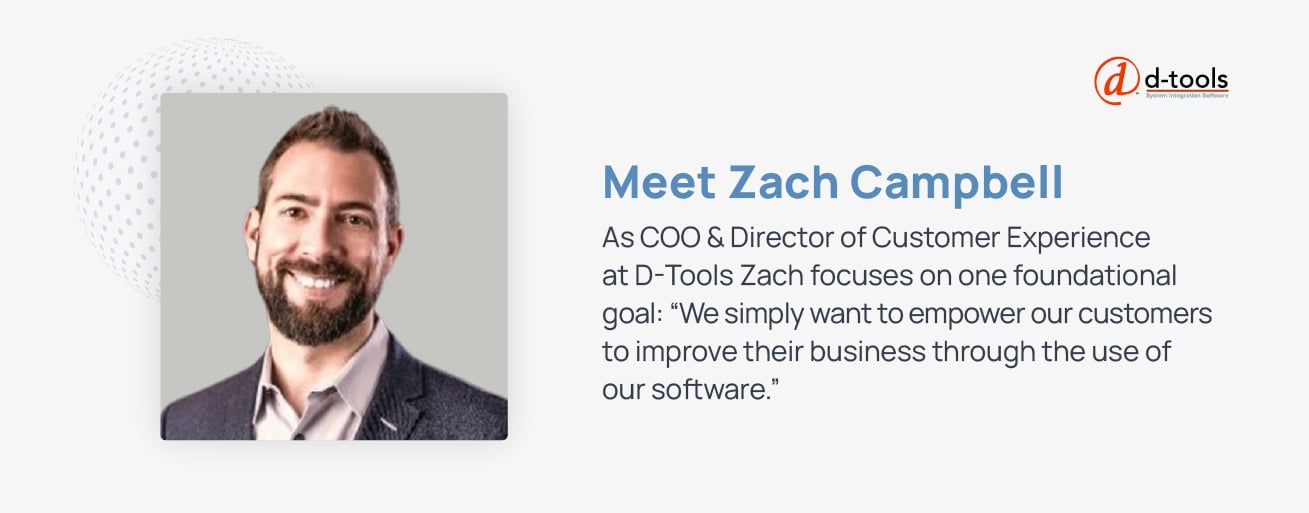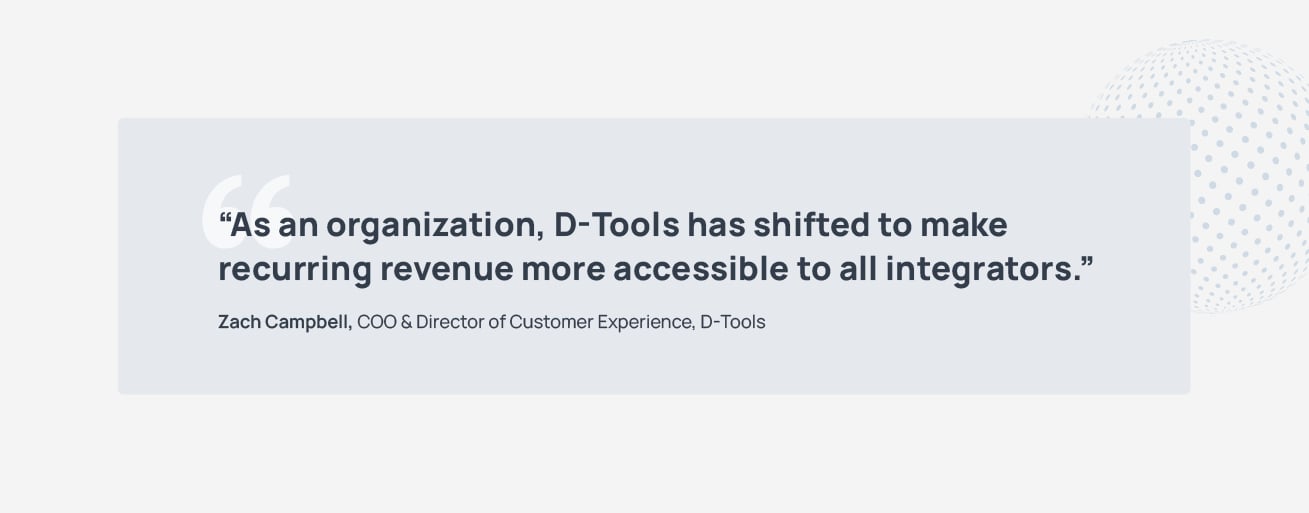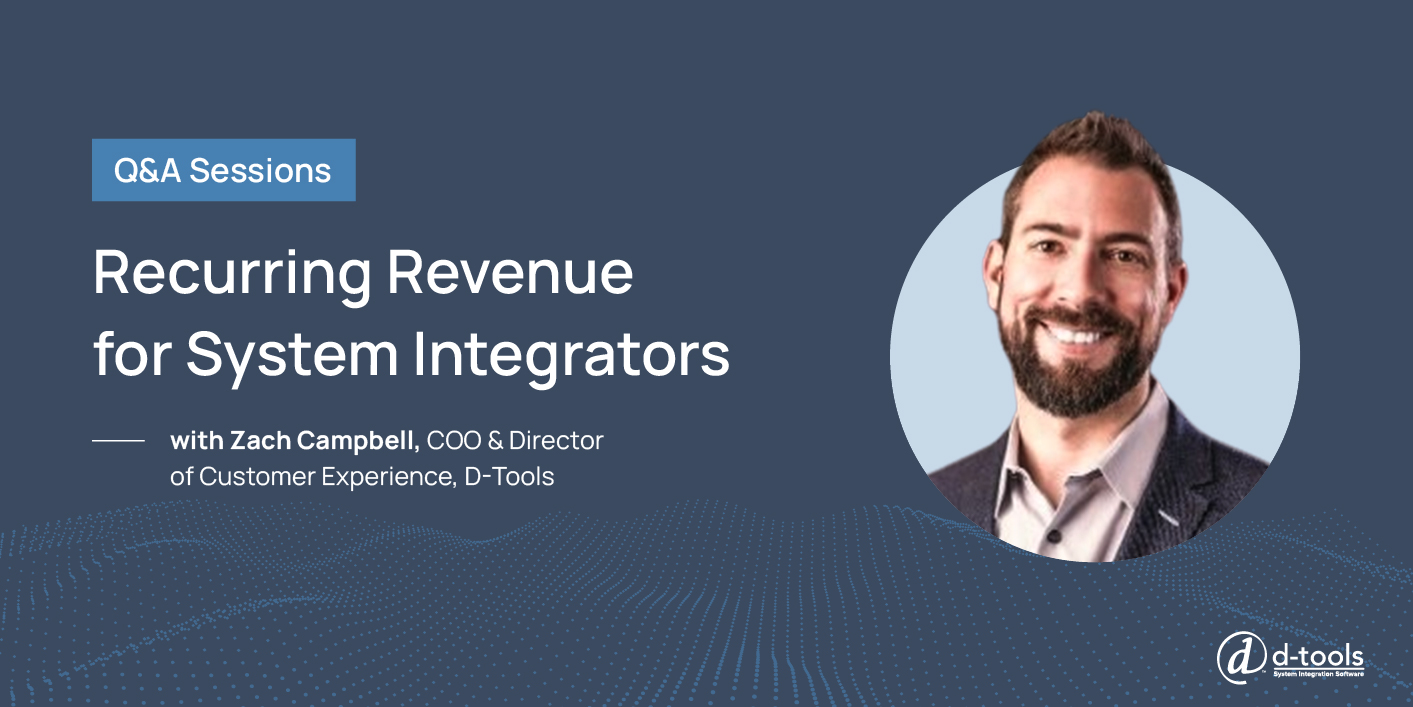Recurring revenue could truly revolutionize system integration.
In order for that to happen, however, integrators must first get comfortable offering service plans to their clients. They must shift their paradigm from an exclusively project-by-project basis and add an additional recurring revenue model.
By spearheading this movement, D-Tools software makes it easy for integrators to offer and manage service plans that enhance relationships and ROI over a protracted period of time.
In today’s Q&A, we’re joined by Zach Campbell, COO & Director of Customer Experience at D-Tools.
An industry veteran of over 15 years, Zach has worked with D-Tools since 2016 and specializes in operations, client retention, support, and account management.
Above all, Zach focuses on one foundational goal: “We simply want to empower our customers to improve their business through the use of our software.”
As we’ll learn, the road to recurring revenue has been met with some resistance — until now.

Thanks for chatting with us today, Zach.
My pleasure!
Before we get into the recurring revenue “revolution,” I’d like to rewind the clock a bit. From a macro level, how do system integrators view their clientele?
Generally speaking, most integrators have traditionally viewed their work as project-based.
Their business model is rather straightforward: find a customer — complete the job — and then rinse and repeat. In fact, most of their time and money spent on marketing is exclusively about finding new customers.
While they’re certainly effective at broadening their clientele, it’s our belief that they’re missing significant revenue within their current customer base.
It’s like they have endless reserves of oil under their feet — they just don’t know it.
They’re not interested in drilling down to find it?
A lot of it has to do with comfortability.
Like I said, most integrators view their jobs on a project-by-project basis. They’re simply not used to thinking about a recurring revenue plan or offering anything beyond warranty service.
Honestly, it comes down to perspective, and that’s what D-Tools is trying to help evolve.
Our software makes it easy for integrators to not only offer service plans, but to define exactly what’s included in those service plans.
They can set the structure — whether it’s on a monthly, quarterly, or annual basis. And once they’ve created, defined, and sold a service plan, they can utilize our software to manage their field service team and measure “used” hours against those projected in their service plans.
>> Related Read - How to Sell Service Plans
How granular does your software get?
Extremely granular.
Integrators can see exactly what services have been completed, when they were completed, and who did the actual work.
Plus, any outstanding items that need to be completed will also be cataloged.
That’s why our software plays a major role in enhancing profitability.
When integrators are doing a lot of reactive service calls, they’re rolling a lot of trucks and may not be able to bill customers with much precision.
However, if you’re billing those calls upfront as part of the service plan, you’ll be way ahead of the curve.
Not only are you more profitable, but you also have fewer things to worry about and process.
There are several services that integrators utilize to monitor the equipment they have installed. With these services, integrators can also proactively monitor their systems remotely.
So, if a device drops off the network or a surge protector goes offline, integrators can call the customer and get ahead of the problem. While this is not a service D-Tools currently provides, D-Tools is the perfect place to keep all the information related to the issue for tracking purposes.
Again, it’s all part of the larger paradigm shift: systems fail. It’s not a question of if but when.
The corollary question then becomes, why wouldn’t integrators capitalize on a recurring revenue model — especially when it’s so readily accessible to them?
So it’s a mindset problem?
Yes, but I also think it’s an issue of confidence.
Most integrators frankly haven't been comfortable selling service plans. They have looked at service as just "something they do for their clients" rather than something they could (and should) be charging for.
Fortunately, the fix is rather easy. Keep reminding customers that a service plan is in their best interests. Equipment fails, firmware updates happen, etc., and someone needs to be on standby to take care of it.
Service plans are a win-win for the customer and integrator alike.

Is this skepticism of service plans pervasive across the industry?
On the commercial AV side, integrators are more likely to embrace service plan offerings.
They have the corporate infrastructure to be more aggressive, as they’re doing AV for corporations and major restaurants, and those applications often require on-going service and upgrades.
Conversely, most residential contractors persist in a project-based mindset. They’re the group we’re most intent on helping.
As an organization, D-Tools has shifted to make recurring revenue more accessible to all integrators.
>> Related Read - 5 Ways to Generate Recurring Business Income
And you’re not alone in that. It seems to be a focus across almost every industry.
Exactly. Subscriptions are a fixture of our society, whether it’s on Amazon, Spotify, or Netflix.
Our hope is that more integrators recognize the ubiquity of recurring revenue models. Subscription services are now the norm, while one-off purchases are becoming a rarity.
For integrators, the dominant question should then become: “how can we better serve our customers once the project is finished?”
That’s a big part of the conversation and makes for a powerful selling point when you’re at the end of a job.
It’s a question of maintenance and longevity — of ensuring their systems work flawlessly and proactively prevent the need for additional, reactive service calls.
Is the end of a job the best time to talk about adding service plans?
There are two ideal times to offer and discuss service plans.
The first one is at the initial contract stage of the project, when you’re sitting down with the customer, listing what they’ve purchased, and identifying how many years of support they’ll have after the system’s installed.
That’s obviously a very natural moment to talk about a service plan.
Of course, the second ideal time is at the end of a project when you’re showing the customer how everything works. They’re likely excited and optimistic and eager to know who they should call if something goes awry.
At that point, you can say, “Just call our support line and you’ll get a response within 24 hours, not including weekends.”
It’s not necessarily bad, but the caveats are clear.
That’s when you make your pitch with something as simple as, “Or, if you sign up for our service plan option, you’ll get 24/7 priority support, a direct number to call, and a guaranteed response within 30 minutes.”
People love concierge service, and the end of a job presents an ideal moment to advertise it.
Again, we encourage integrators to emphasize the “service” in service plans. Yes, it’s a subscription, but it will guarantee the highest level of client care.
At D-Tools, we believe that outstanding customer service and high retention are intertwined.
>> Related Read - Why After-Sales Service Is Important
Considering the state of the economy, this sounds like a financial lay-up for integrators.
Right? Holding on to customers is mission-critical right now.
The way we see it, service plans help preserve relationships in our increasingly remote society.
The pandemic indelibly changed the cultural landscape, and going forward, service plans will help keep integrators and customers in closer contact.
Service plans can promote profitability for integrators while enhancing customer service at every touchpoint.
Can integrators get creative within your software?
Yes. D-Tools software enables integrators to build out a service plan with models that play to their individual strengths.
In other words, integrators can develop a fully tiered lineup for their customers – like a Silver, Gold, and Platinum package offering.
Those are obviously generic titles, but our software empowers integrators to customize their service plans however they like.
What’s the ideal timeline for a service contract?
Most customers are comfortable talking about a one-year plan. That’s usually the baseline.
At D-Tools, however, we encourage integrators to aim for three- and even five-year service plans.
Again, this will require a certain paradigm shift (and some increased sales confidence), but the recurring revenue opportunity has major upside potential.
How can people get more comfortable selling a service plan?
The compensation always needs to reflect the effort. You need to incentivize your sales people to include a multi-year service plan.
Honestly, that probably means adjusting the commission structure to favor a recurring revenue model.
It’s easy to forget that the sales team is the first point of contact, the first evangelist with the customer.
That’s a huge responsibility, and they need to feel supported — and rewarded — for providing white-glove service and establishing what we hope will be a long-term relationship.
How do service plans create opportunities for cross-department collaboration to determine the customer needs?
For starters, it’s important to recognize that the systems our customers are providing can be rather complex — both in terms of design and installation.
That can include cabling (rough-in), installation, project management, and much more.
Then, you have to concentrate on programming, user interfaces, remotes and systems, and ensure that they all operate successfully.
It’s a deeply intricate process that goes beyond examining one piece of equipment.
>> Related Read - How to Write an Audio Visual Service Contract
So how do you determine pricing structure?
The pricing structure has to reflect the cross-departmental nature of the service plan.
It’s more complicated than putting your finger in the air and saying, “Okay, we’ll charge $99 a month for this suite of services.”
Multiple teams are involved, from sales to production, and their perspective will help determine pricing.
It all starts with the right questions: How was the project installed? How easy is it to maintenance? Where do you maintenance it?
These questions need to be discussed organizationally, and data sets need to be collected at every level.
Maybe the project was designed with one intent and installed with another.
That would inspire a new set of questions, including: How exactly was the system designed versus how was it specified? How is it programmed? Does it work differently than our normal systems? If so, why does it work that way?
To get the right answers, all of these teams have to come together.
They need to have clear guidelines of what they’re looking for at every touchpoint.
They need to be fully in sync about what they’re offering, how they’re installing it, how they’re programming it, and how they’re going to service that system down the line.
To answer your question about pricing, when I was a residential systems integrator, we ultimately used a percentage of the entire project — combining the cost of equipment and labor — as our baseline for the annual operating cost.
This figure was never set at some arbitrary number, like $249.99 a month. Instead, it was always related to the size and complexity of the given project.
The reality is, you can’t know the true cost of a job until you show up on site and assess all the unexpected variables and factors.
That’s how you open the door to recurring revenue. At D-Tools, we’re excited to see more integrators walk through it in 2023 and beyond.
>> Related Read - How to Increase Revenue from Existing Customers





